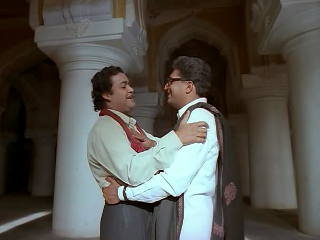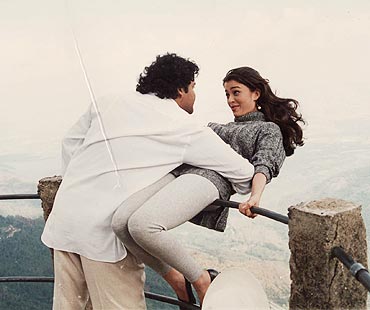Directed by Mani Ratnam
Written by Mani Ratnam, Suhasini
Cinematography Santosh Sivan
Starring Mohanlal, Prakash Raj, Aishwarya Rai
Mani Ratnam called Iruvar- the original title of the film- his best work (so far). As far his other films go, I remember watching only Nayakan, Anjali and Mouna Ragam, and my memory of these films are too distant to make any remark on them, having seen them at a time when I had not yet donned the 'cinephile' mantle. But I would not hesitate to call it one of his best, in spite of its shortcomings.
Set in Tamil Nadu in pre-independence India, The Duo charts the lives of the actor Anandan (Mohanlal) and the writer-cum-politician Tamilselvam (Prakash Raj) over a period of four decades. The two meet as ambitious young men who want to make it big in the world. Both become successful in their respective fields, each using the other for boosting mass appeal. But with time they become increasingly distant, giving way to jealousy, which is then transformed into political rivalry when Anandan makes his foray into politics, usurping his once-close friend as Chief Minister of Tamil Nadu. The film then concludes with Anandan's death while in office, and that is when the bond between the two protagonists is eventually reconciled. A major sub-plot of the film involves the private lives of the two friends, and how they shape the development of the protagonists' lives, and subsequently, the narrative.
As is very well known, the film is a slightly fictionalised account of the relationship between the legendary MG Ramachandran ('MGR' as he is popularly known) and DMK chief M Karunanidhi and attempts to examine the eerie relationship between cinema and politics in South India, especially Tamil Nadu. The narrative progresses in episodic fashion as it shifts between the lives of each of the protagonists as they move through each phase of their lives.
Unfortunately though, what was intended to be a fictional account of two of the most influential lives in the recent history of Tamil Nadu ends up looking something like a fictional biography of the actor Anandan, thanks to six song sequences devoted exclusively to him and a more-than-cursory emphasis on his private life, largely to boost the career of then débutante Aishwarya Rai. As director Ratnam himself admitted in the recent book Conversations with Mani Ratnam, a selection of interviews with critic Baradwaj Rangan, the fact that the film was set largely in tinsel town gave him an excuse to include a number of song sequences that, while being placed in films within the film, also underlines the development of events in the star's personal life, besides drawing the crowds to the cinemas (the film failed there, however).
While the idea is no doubt commendable, six songs put together constitutes significant screen time which could very well have been devoted to the film's core concern, which is all but overshadowed. As a result, the film not only loses its equilibrium but also risks seeming obscure to an outsider, who is likely to question the plausibility of a screen idol suddenly becoming Chief Minister of a state.
And yet, The Duo remains a remarkable movie for a number of reasons- a screenplay that contains several scenes of inspired brilliance, backed by equally inspired lead performances from Mohanlal and Prakash Raj. Mohanlal is especially memorable in this film, delivering probably one of the five best performances of his career. Undoubtedly, the effortless ease and spontaneity with which he is able to articulate otherwise complex states of mind purely through facial and bodily expression instead of dialogue, is some achievement, and something that is sorely missing from his work of the past decade and a half. And when I say that I decided to watch this film solely to watch his performance, I am not exaggerating.
Mani Ratnam's mise-en-scene here also deserves mention. As he revealed in the book, he sought a rapid departure in style, minimising editing and covering sequences in single takes in several instances. And this he seems to have pulled of remarkably; some of the film's sequence shots seem to be straight out of Mizoguchi (I'm not sure, however, if Ratnam was consciously emulating the great master). As always, he makes the best use of available lighting to create visuals which, while being beautiful in their own right, do not become obtrusive.
With all its virtues, a little more attention to the narrative could have made the film a genuine masterpiece. But Mani Ratnam still cannot shake himself of some of the banal conventions of our commercial cinema. He still had to have that scene where the hero waits until the train moves to say goodbye to his beloved wife.
Written by Mani Ratnam, Suhasini
Cinematography Santosh Sivan
Starring Mohanlal, Prakash Raj, Aishwarya Rai
Mani Ratnam called Iruvar- the original title of the film- his best work (so far). As far his other films go, I remember watching only Nayakan, Anjali and Mouna Ragam, and my memory of these films are too distant to make any remark on them, having seen them at a time when I had not yet donned the 'cinephile' mantle. But I would not hesitate to call it one of his best, in spite of its shortcomings.
Set in Tamil Nadu in pre-independence India, The Duo charts the lives of the actor Anandan (Mohanlal) and the writer-cum-politician Tamilselvam (Prakash Raj) over a period of four decades. The two meet as ambitious young men who want to make it big in the world. Both become successful in their respective fields, each using the other for boosting mass appeal. But with time they become increasingly distant, giving way to jealousy, which is then transformed into political rivalry when Anandan makes his foray into politics, usurping his once-close friend as Chief Minister of Tamil Nadu. The film then concludes with Anandan's death while in office, and that is when the bond between the two protagonists is eventually reconciled. A major sub-plot of the film involves the private lives of the two friends, and how they shape the development of the protagonists' lives, and subsequently, the narrative.
As is very well known, the film is a slightly fictionalised account of the relationship between the legendary MG Ramachandran ('MGR' as he is popularly known) and DMK chief M Karunanidhi and attempts to examine the eerie relationship between cinema and politics in South India, especially Tamil Nadu. The narrative progresses in episodic fashion as it shifts between the lives of each of the protagonists as they move through each phase of their lives.
Unfortunately though, what was intended to be a fictional account of two of the most influential lives in the recent history of Tamil Nadu ends up looking something like a fictional biography of the actor Anandan, thanks to six song sequences devoted exclusively to him and a more-than-cursory emphasis on his private life, largely to boost the career of then débutante Aishwarya Rai. As director Ratnam himself admitted in the recent book Conversations with Mani Ratnam, a selection of interviews with critic Baradwaj Rangan, the fact that the film was set largely in tinsel town gave him an excuse to include a number of song sequences that, while being placed in films within the film, also underlines the development of events in the star's personal life, besides drawing the crowds to the cinemas (the film failed there, however).
While the idea is no doubt commendable, six songs put together constitutes significant screen time which could very well have been devoted to the film's core concern, which is all but overshadowed. As a result, the film not only loses its equilibrium but also risks seeming obscure to an outsider, who is likely to question the plausibility of a screen idol suddenly becoming Chief Minister of a state.
And yet, The Duo remains a remarkable movie for a number of reasons- a screenplay that contains several scenes of inspired brilliance, backed by equally inspired lead performances from Mohanlal and Prakash Raj. Mohanlal is especially memorable in this film, delivering probably one of the five best performances of his career. Undoubtedly, the effortless ease and spontaneity with which he is able to articulate otherwise complex states of mind purely through facial and bodily expression instead of dialogue, is some achievement, and something that is sorely missing from his work of the past decade and a half. And when I say that I decided to watch this film solely to watch his performance, I am not exaggerating.
Mani Ratnam's mise-en-scene here also deserves mention. As he revealed in the book, he sought a rapid departure in style, minimising editing and covering sequences in single takes in several instances. And this he seems to have pulled of remarkably; some of the film's sequence shots seem to be straight out of Mizoguchi (I'm not sure, however, if Ratnam was consciously emulating the great master). As always, he makes the best use of available lighting to create visuals which, while being beautiful in their own right, do not become obtrusive.
With all its virtues, a little more attention to the narrative could have made the film a genuine masterpiece. But Mani Ratnam still cannot shake himself of some of the banal conventions of our commercial cinema. He still had to have that scene where the hero waits until the train moves to say goodbye to his beloved wife.


